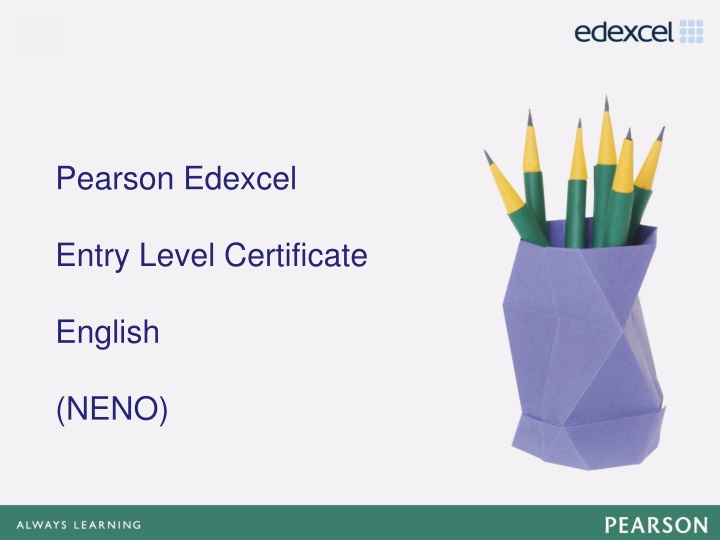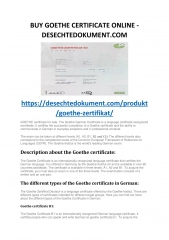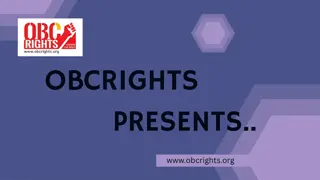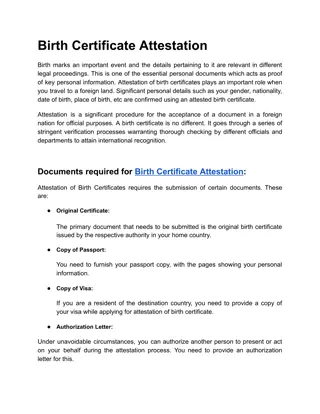Overview of Pearson Edexcel English Entry Level Certificate (NENO)
This overview provides details on the Pearson Edexcel English Entry Level Certificate (NENO) qualifications, including key features such as flexible assessments, engaging topics, and alignment with GCSE standards. It covers components like Speaking and Listening, Writing, and Reading, offering insights into the qualification structure, assessment options, and available support materials for teachers and centers. The content showcases the levels available, internal assessments, and external moderation, emphasizing the resources provided and the freedom for centers to select tasks.
Download Presentation

Please find below an Image/Link to download the presentation.
The content on the website is provided AS IS for your information and personal use only. It may not be sold, licensed, or shared on other websites without obtaining consent from the author.If you encounter any issues during the download, it is possible that the publisher has removed the file from their server.
You are allowed to download the files provided on this website for personal or commercial use, subject to the condition that they are used lawfully. All files are the property of their respective owners.
The content on the website is provided AS IS for your information and personal use only. It may not be sold, licensed, or shared on other websites without obtaining consent from the author.
E N D
Presentation Transcript
Click to edit Master title style Click to edit Master text styles Second level Third level Fourth level Fifth level Entry Level Certificate Pearson Edexcel English (NENO)
Session Agenda Click to edit Master title style This training is to support centres and teachers with Getting Ready to Teach the new Entry Level Certificate in English Click to edit Master text styles Second level Third level Fourth level Fifth level look at the requirements for each of the three components: Delegates will: receive an introduction to the qualification be given content guidance Speaking and Listening, Writing and Reading (fiction and non- fiction) learn about the support materials available be invited to ask questions.
Key Features Click to edit Master title style Click to edit Master text styles Second level Third level Fourth level Fifth level Engaging topics suggested by English teachers. Mapped/aligned to GCSE English Language - can be used as an alternative qualification for students who cannot achieve GCSE. Can also be used as a springboard to and preparation for GCSE. Flexible with lots of choice. Free choice of Speaking and Listening and Writing tasks or teachers can follow tasks set by Edexcel. Continued
Key Features (continued) Click to edit Master title style Set Reading assessments. Choice of papers. 3 sets of live Click to edit Master text styles Second level Third level Fourth level Fifth level Can take assessments at any time during the year. papers, each on a different topic, are available. Teachers can choose the one best suited to the student. Assessment objectives in line with GCSE. AO3 comparison assessed in Spoken Language task for Levels 1 and 2 to make the qualification more accessible. Level 3 Reading Fiction includes some very short extracts of 19th century texts, as well as 20thand 21stcentury texts.
Content Overview Click to edit Master title style Three Levels available. All components are internally assessed and externally moderated. Click to edit Master text styles Second level Third level Fourth level Fifth level a bank of free resources provided Speaking and Listening centres are free to choose tasks or use any from a bank of free resources provided Writing centres are free to choose tasks or use any from Reading Fiction Three sets of papers available for each level. Centres can choose which ones to use Reading Non-fiction Three sets of papers available for each level. Centres can choose which ones to use
Marking and Moderation Click to edit Master title style Tasks are to be marked by the teacher according to the assessment criteria in the specification and moderated by Pearson. Click to edit Master text styles Second level Third level Fourth level Fifth level The final marks awarded for the task(s) must be submitted to Pearson on an Assessment Record and Authentication Sheet (see Appendix 1 in the specification) by 15th May in the year of certification. Students can carry out as many tasks as they wish. The best marks for each task should be selected and submitted as the final marks. Pearson will then moderate the work. The student s total mark out of 100 for all three components establishes whether they have achieved the Entry Level. For further information, see the Level of Achievement section (page 45 of the specification). Students can retake any component.
Click to edit Master title style Component 1: Speaking and Listening Click to edit Master text styles Second level Third level Fourth level Fifth level use Standard English as appropriate Enables students to: speak confidently, audibly and effectively select and organise information and ideas effectively listen and respond to questions.
Component 1: Speaking and Listening Click to edit Master title style Entry Level 1 and Entry Level 2 Click to edit Master text styles Second level Third level Fourth level Fifth level Task 1: 8 marks, 8% Task 2: 12 marks, 12%* 20% of the qualification 20 marks Assessment overview Students complete two tasks Suggested timings per task: Level 1: 2 4 minutes and Level 2: 3-5 minutes. * Task 2 includes a comparison of 2 ideas (the additional 4 marks are for AO3 comparison)
Click to edit Master title style Component 1: Speaking and Listening Entry Level 3 Click to edit Master text styles Second level Third level Fourth level Fifth level 10 marks, 10% 10% of the qualification 10 marks Assessment overview Students complete one task. Suggested timing for task: 4 6 minutes.
Component 1: Speaking and Listening Click to edit Master title style Tasks can be devised by the centre. Click to edit Master text styles Second level Third level Fourth level Fifth level specification can be used or adapted. Alternatively, the resources provided in the A bank of teaching resources is available for centres to use or adapt.
Component 1: Speaking and Listening Click to edit Master title style Expected Outcomes The specification provides examples of expected outcomes. These can be used as a guide when awarding marks. Click to edit Master text styles Second level Third level Fourth level Fifth level Example: Task 1: Who are you? Expected outcomes Entry Level 2 Entry Level 1 Entry Level 3 Students will be able to: Students will be able to: Students will be able to: give their name and age and where they live give their name and date of birth, and say if they have any brothers and sisters give an extended talk to include details about who they are and present information about their family/carers talk about whether they have any brothers and sisters and provide some information about them. include some additional information, such as whether they have any pets and what they like to do in their spare time. develop ideas to include their dreams and ambitions for the future and any other information that will interest the listener.
Component 1: Speaking and Listening Click to edit Master title style Speaking and Listening tasks: do not have to be recorded Click to edit Master text styles Second level Third level Fourth level Fifth level records of assessments must be kept. can be taken any time can be completed with just the teacher or assessor present Assessment Records: centres must complete an assessment sheet for each student can be kept electronically or as hard copies comments should be personalised to each student comments should support the justification for awarding of marks.
Component 1: Speaking and Listening Click to edit Master title style An Assessment Record Click to edit Master text styles Second level Third level Fourth level Fifth level specification. Sheet can be found in the appendix of the
Click to edit Master title style Component 2: Writing Enables students to: Click to edit Master text styles Second level Third level Fourth level Fifth level select vocabulary, form, and structural and organisational adapt their writing for different purposes and audiences select and organise ideas, facts and key points features to reflect audience, purpose and context, and use Standard English where appropriate pay attention to the accuracy and effectiveness of grammar, punctuation and spelling.
Component 2: Writing Entry Level 1 and Entry Level 2 Click to edit Master title style 30% of the qualification 30 marks Click to edit Master text styles Second level Third level Fourth level Fifth level or two creative pieces of writing or two transactional pieces of writing. Assessment overview Students complete two tasks. These can be either: one transactional piece of writing and one creative piece of writing Each task is worth 15% and 15 marks. Suggested timings per task: Level 1, 15 minutes and Level 2, 30 minutes.
Component 2: Writing Click to edit Master title style Entry Level 3 40% of the qualification 40 marks Click to edit Master text styles Second level Third level Fourth level Fifth level one creative piece of writing. Assessment overview Students complete two tasks: one transactional piece of writing and Each task is worth 20% and 20 marks. Suggested timings per task: 40 minutes.
Component 2: Writing Click to edit Master title style Tasks can be devised by the centre. Click to edit Master text styles Second level Third level Fourth level Fifth level specification can be used or adapted. Alternatively, the resources provided in the A bank of free teaching resources is available for centres to use or adapt.
Component 2: Writing Entry Level 1 This assessment is out of 30 marks. Each task: Click to edit Master title style is worth 15 marks (15%) AO5 and AO6 are assessed AO5 is worth 12 marks AO6 is worth 3 marks. Click to edit Master text styles Second level Third level Fourth level Fifth level AO5 and AO6 are assessed AO5 is worth 10 marks AO6 is worth 5 marks. Entry Level 2 This assessment is out of 30 marks. Each task: is worth 15 marks (15%) Entry Level 3 This assessment is out of 40 marks. Each task: is worth 20 marks (20%) AO5 and AO6 are assessed AO5 is worth 12 marks AO6 is worth 8 marks.
Component 2: Writing Click to edit Master title style Expected Outcomes The specification provides examples of expected outcomes. These can be used as a guide when selecting tasks and entering students for the appropriate level. Click to edit Master text styles Second level Third level Fourth level Fifth level Task 1: Write the opening of a short story entitled Lost and Alone Example: Expected outcomes Entry Level 1 Entry Level 2 Entry Level 3 Writes a brief opening to a story, with a short description of a character or place. Writes a straightforward opening to a story, with a description of the place, the landscape or the feelings of a character. Writes the opening of a story that engages the reader. Includes descriptions of the setting, the atmosphere of the place or the feelings of the characters. Ideas are more developed, using language features and detail. Ideas may be in bullet points or captions to images that tell the story.
Component 2: Writing Click to edit Master title style Teachers must use the criteria in the specification when marking the writing tasks. Click to edit Master text styles Second level Third level Fourth level Fifth level Teachers should add brief comments to an Assessment Record and Authentication sheet (please see Appendix 1 of the specification) to support the marks awarded. There are no marks awarded for planning. Teachers should also write brief comments on the completed tasks to indicate how marks were awarded. Assessment materials (for all components and levels, including student responses and Assessment Record sheets) should be kept safe for external moderation.
Component 3: Reading Click to edit Master title style Fiction and Non-fiction Click to edit Master text styles Second level Third level Fourth level Fifth level identify and interpret ideas and information Enables students to: read in different ways for different purposes seek evidence in the text to support a point of view identify and comment on a writer s choice of vocabulary. Students will read short extracts from both fiction and non-fiction 20th- and 21st-century texts (plus 19th-century fiction at Level 3).
Component 3: Reading Click to edit Master title style 50% of the qualification 50 marks Click to edit Master text styles Second level Third level Fourth level Fifth level Students take two tests: Assessment overview Tests are provided by Pearson and can be downloaded from the website. Tests are themed and teachers can choose which tests to give students. non-fiction, 25% (25 marks) o fiction, 25% (25 marks). o Suggested timings per test: Level 1, 30 minutes and Level 2, 35 minutes, Level 3, 45 minutes. At Level 3 there will be one comparison question (AO3) in the non-fiction test.
Component 3: Reading Test requirements Click to edit Master title style All students must take two tests: one non-fiction test and Click to edit Master text styles Second level Third level Fourth level Fifth level non-fiction and fiction. one fiction test. Teachers will select live tests from a choice of three for both Teachers can read out the introductions, given in italics, to each text and the questions but not the texts themselves. No dictionaries or thesauri are allowed.
Component 3: Reading Non-fiction Click to edit Master title style The reading papers will contain a range of question types, for example: Click to edit Master text styles Second level Third level Fourth level Fifth level matching exercises open questions true/false statements tick boxes identification/labelling text ordering cloze exercises
Component 3: Reading Non-fiction Click to edit Master title style For Level 3 Reading, Non- fiction only, students will be asked to draw comparisons between texts. Click to edit Master text styles Second level Third level Fourth level Fifth level For example, in the Sample Assessment Materials (SAMs), students are asked to complete the grid. Examples are provided for the student.
Component 3: Reading Fiction Click to edit Master title style The Reading fiction papers, like the non-fiction, have a range of question types. Click to edit Master text styles Second level Third level Fourth level Fifth level features, such as verbs, nouns, adjectives and adverbs. Some questions may ask students to comment on the effect of a specific word or to identify basic language In Level 1 and Level 2, texts are helpfully broken down into bite-size chunks to make them more accessible. Difficult words are glossed.
Component 3: Reading Marking the papers Click to edit Master title style Centres mark their own papers and keep them secure for external moderation. Click to edit Master text styles Second level Third level Fourth level Fifth level For example, in a four marks question, the correct answers are clearly identified. The mark schemes are clear and straight-forward to use.
Support Materials Click to edit Master title style Our website contains a range of free support materials. Click to edit Master text styles Second level Third level Fourth level Fifth level can expect to see. Please refer to the Sample Assessment Materials (SAMs) for example Reading papers (fiction and non-fiction). The SAMs will illustrate the different types of questions that students The Mark Schemes for each paper are clear, concise and easy to use.
Click to edit Master title style Click to edit Master text styles Second level Third level Fourth level Fifth level Any questions?
Click to edit Master title style Contact information English Subject Advisor, Clare Haviland: Click to edit Master text styles Second level Third level Fourth level Fifth level http://www.edexcel.com/Subjects/English/Pages/Default.aspx teachingenglish@pearson.com Tel: 0207 010 2183 English forum look at and participate in: www.community.edexcel.com/english/default.aspx Twitter: @PearsonTeachEng www.edexcel.com/learningforabetterfuture























